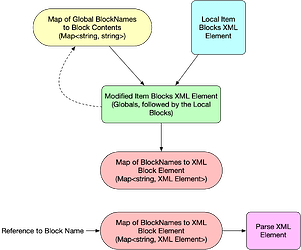This page extends the proposed changes to Item Blocks mention in here.
In the current implementation, the contents of an ItemBlock are copied exactly. I proposed extending this to allow for parameterization of the Block so that when it is instantiated, the consumer can specify new content.
Existing Item Blocks
Here is an example of defining and using Item Blocks:
<ItemBlocks>
<Block Name="B1">
<ItemDefinitions>
<String Name="s1">
<Categories>
<Cat>Solid Mechanics</Cat>
</Categories>
</String>
<Int Name="i1">
<DefaultValue>0</DefaultValue>
</Int>
</ItemDefinitions>
</Block>
</ItemBlocks>
<Definitions>
<AttDef Type="Type0">
<Categories>
<Cat>Fluid Flow</Cat>
</Categories>
<ItemDefinitions>
<Double Name="foo"/>
<Block Name="B1"/>
<String Name="bar"/>
</ItemDefinitions>
</AttDef>
</Definitions>
The following figure depicts how Item Blocks are currently processed:
The XML attribute reader maintains a global dictionary of exported serialized Item Blocks and are keyed to the Block’s name. When processing a template file, these global blocks converted into XML elements and are prepended to those defined in the local template file. All of these XML elements are then traversed and are used to form a dictionary of XML elements. If we encounter an exported Item Block in the local template file, the element is serialized and added to the Global dictionary.
When a Block is referenced, the name is looked up in the XML Element map and the located element is parsed.
Now let’s assume we want to parameterize the Block so that the default value and label of i1 to be redefined when the Block is referenced. In this case I am proposing that we replace the name Block with the name Template.
<Templates>
<Template Name="B1">
<Parameters>
<Param Name = "def1"> 0 </Param>
</Parameters>
<Contents>
<ItemDefinitions>
<String Name="s1">
<Categories>
<Cat>Solid Mechanics</Cat>
</Categories>
</String>
<Int Name="i1" Label="IntLabel{def1}">
<DefaultValue>{def1}</DefaultValue>
</Int>
</ItemDefinitions>
<Contents>
</Template>
</Templates>
<Definitions>
<AttDef Type="Type0">
<ItemDefinitions>
<Template Name="B1">
<Param Name="def1"> 15 </Param>
</Template>
</ItemDefinitions>
</AttDef>
<AttDef Type="Type1">
<ItemDefinitions>
<Template Name="B1"/>
</ItemDefinitions>
</AttDef>
</Definitions>
In the above example, the Template B1 has a parameter def1 that has a default value of 0. Definition Type0 references B1 with the parameter def1 set to 15, would contain an Int Item Definition i1 with a label named IntLabel15 and has a default value of 15. Definition Type1 is referencing B1 with def1 set to its default value of 0 resulting in its i1 Int Item Definition with a label of IntLabel0 and a default value of 0.
To support such a feature I would propose the following:
In this case I’ve added a data structure called TemplateInfo. TemplateInfo contains a string that represent the XML contents (same as the original Block content) and a map of parameters strings to string values that represent the default parameter values.
The reader will maintain a map of global Template Names to TemplateInfos.
When an new template file is processed, a local map is created from the global map and if the template file contains a Templates XML element, its contents are added to the local map (as well as to the global map if the template is exported).
When a template reference is found, the following is performed:
- Create a new copy of the referenced template’s parameters and add any parameter mentioned in the template reference.
- Do a string substitution of all of the parameters in the local copy into the template contents to form a new string that will be deserialized to form an new XML element
- Process the new XML element

